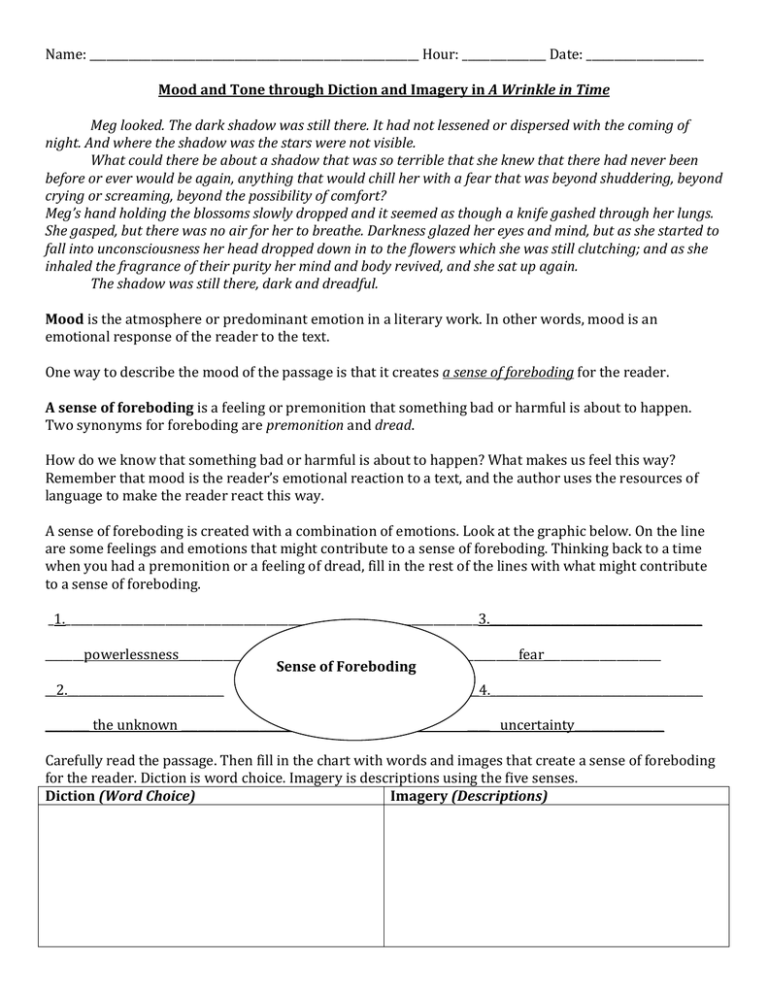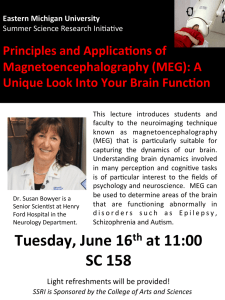Mood and Tone through Diction and Imagery Assignment
advertisement

Name: ___________________________________________________________ Hour: _______________ Date: _____________________ Mood and Tone through Diction and Imagery in A Wrinkle in Time Meg looked. The dark shadow was still there. It had not lessened or dispersed with the coming of night. And where the shadow was the stars were not visible. What could there be about a shadow that was so terrible that she knew that there had never been before or ever would be again, anything that would chill her with a fear that was beyond shuddering, beyond crying or screaming, beyond the possibility of comfort? Meg’s hand holding the blossoms slowly dropped and it seemed as though a knife gashed through her lungs. She gasped, but there was no air for her to breathe. Darkness glazed her eyes and mind, but as she started to fall into unconsciousness her head dropped down in to the flowers which she was still clutching; and as she inhaled the fragrance of their purity her mind and body revived, and she sat up again. The shadow was still there, dark and dreadful. Mood is the atmosphere or predominant emotion in a literary work. In other words, mood is an emotional response of the reader to the text. One way to describe the mood of the passage is that it creates a sense of foreboding for the reader. A sense of foreboding is a feeling or premonition that something bad or harmful is about to happen. Two synonyms for foreboding are premonition and dread. How do we know that something bad or harmful is about to happen? What makes us feel this way? Remember that mood is the reader’s emotional reaction to a text, and the author uses the resources of language to make the reader react this way. A sense of foreboding is created with a combination of emotions. Look at the graphic below. On the line are some feelings and emotions that might contribute to a sense of foreboding. Thinking back to a time when you had a premonition or a feeling of dread, fill in the rest of the lines with what might contribute to a sense of foreboding. _1.__________________________________________________________________________3.______________________________________ _______powerlessness_________________________ Sense of Foreboding __2.____________________________ ________ the unknown ________________________________________ ____________fear_____________________ __4._________4.______________________________________ ____ uncertainty________________ Carefully read the passage. Then fill in the chart with words and images that create a sense of foreboding for the reader. Diction is word choice. Imagery is descriptions using the five senses. Diction (Word Choice) Imagery (Descriptions) Tone is the writer or speaker’s attitude toward a subject, character, or audience. It is conveyed, or shown, through the author’s choice of diction, imagery, figures of speech, and syntax. In this case the writer also seems to have a sense of foreboding. Look back at the words on the circle graphic and the words and images used on the chart above. How many of these words describe how the speaker feels? Link as many words from the circle graphic to the words and images in the chart that seem to express that feeling. Graphic Diction Imagery Powerlessness dread “chill her with a fear” dark “beyond shuddering, beyond terrible crying or screaming” dreadful “Darkness glazed her eyes and gasped mind” Now fill in the blanks to describe how some of the words and images express the speaker’s tone. The first one is done for you. The speaker’s description of Meg’s feeling of powerlessness is illustrated through the use of the image that “darkness glazed her eyes and mind.” The speaker indicates that Meg is unable to escape from the reach of the darkness. The darkness is personified making it seem powerful and in control while Meg is helpless. 1. The speaker’s description of Meg’s feeling of ___________________________ is illustrated through the use of the image “__________________________________________________________________________________________________________.” The speaker indicates that Meg ___________________________________________________________________________________. 2. The speaker’s description of Meg’s feeling of ___________________________ is illustrated through the use of the image “__________________________________________________________________________________________________________.” The speaker indicates that Meg ____________________________________________________________________________________.
